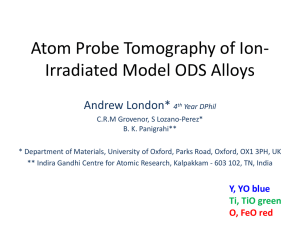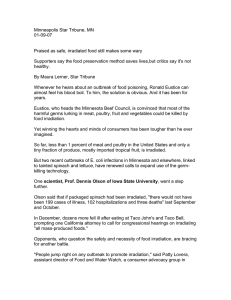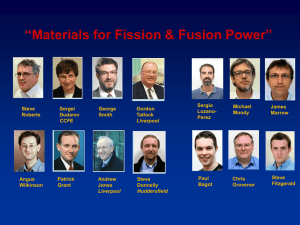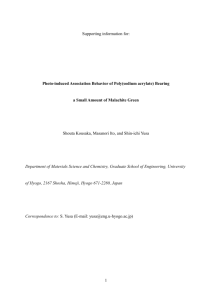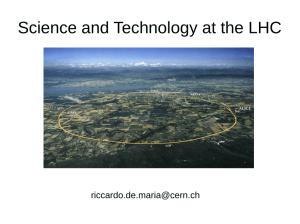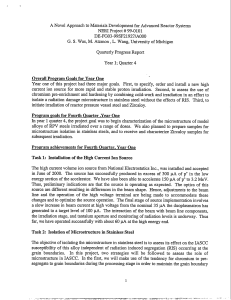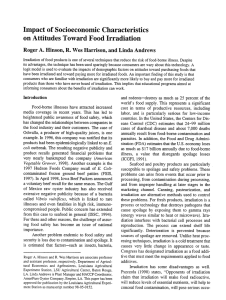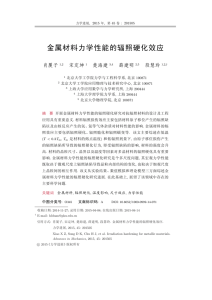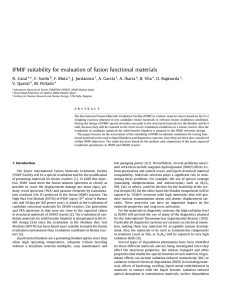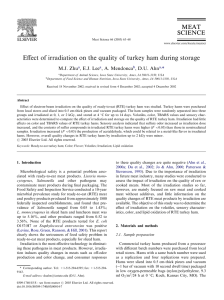eucard-2_annual_ALBA_Apr15 - Indico
advertisement
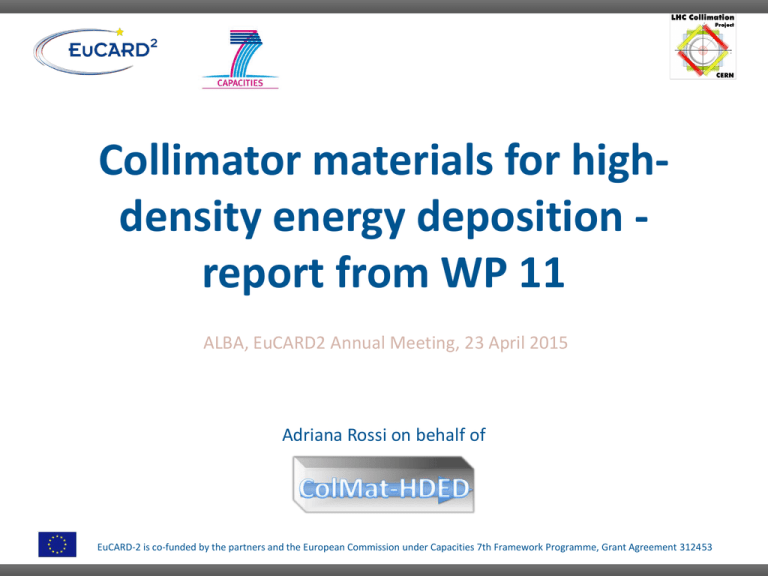
Collimator materials for highdensity energy deposition report from WP 11 ALBA, EuCARD2 Annual Meeting, 23 April 2015 Adriana Rossi on behalf of EuCARD-2 is co-funded by the partners and the European Commission under Capacities 7th Framework Programme, Grant Agreement 312453 ColMat-HDED collaboration and beyond • ColMat-HDED partners: scientific, industrial, extra-EU NRC KI • Partnership agreement with CERN (KN2045) • Collaboration CERN with US-LARP Material studies Requirements • Higher robustness (LHC beam energy density up to 15 GJ/mm2, 23 orders > other machines). • Lower impedance since collimators give, by far, the highest contribution to machine impedance, potentially leading to serious beam instabilities. • Larger resistance to radiation (1E16 p/y doses in LHC betatron cleaning insertion). • Higher absorption (clean efficiency for machine protection) Experimental characterisation: • • • Irradiation Beam impact Thermo-mechanical tests Thermo-mechanical and beam simulations Radiation damage simulations Some material science: MoGr Courtesy of M. Tomut (GSI) • Molybdenum-Graphite CF reinforced Graphite crystallite is strongly anisotropic, having different physical properties for in-plane and transverse direction. If the graphite grains are correctly oriented along the planar direction, then in this direction the extraordinary properties can be realized. In addition Graphite and to molybdenum MoGr, Carbonhave Fibera (CF) chemically is also added. affinity CF’s for each haveother. been widely used as a reinforcing The hexagonal phase for the advanced Mo2C cancomposites be formed due when tothe their powders extraordinary of graphite physical and and molybdenum mechanical are heated to 1000°C. During properties, such asthe high process strength of the andreaction, high thermal carbon conductivity. atoms diffuse inside the molybdenum bcc lattice interstitials. When the amount of carbon reaches about 33%at the molybdenum grain is totally transformed. 2Mo + C ↔ Mo2C As the amount of carbon further increases, the MoC carbide is formed. MoC carbide exhibits good mechanical properties if it can be finely dispersed inside the Mo2C matrix, while the strength of the final composites can be reduced if MoC exists at the grain boundary. Therefore, it is essential to find an adequate temperature of the thermal treatment to ensure a fine dispersion of MoC inside the Mo2C matrix. Experimental characterisation • GSI irradiation tests with swift heavy ions In-plane and transverse MoGr samples irradiated at ≈ Bragg peak energy with Au U ions, with doses from 1E11 to 5E13 ions/cm2. • All investigation methods (Laser Flash Method, Raman Spectroscopy, SEM, X-ray diffraction) show better stability if samples annealed prior exposure (so far 1150°C and 1300°C - 1800°C yet to be measured). • There seem to be a threshold dose for damage (to be understood). • Maximum irradiation dose should not be reached at LHC. • Irradiation above ion track formation. At higher accumulated doses the transverse samples are deforming, whereas the in-plane samples experience no change of the shape. Optimization of radiation hardness of these samples has been done by preirradiation annealing. Experimental characterisation Thermal expansion coefficient, Mo-D, 30 MeV protons Т, °С • NRC KI 20 50 100 α, 10-6 1/К Irradiated Sample 1 7,5 Sample 2 8,1 Sample 3 8,3 α, 10-6 1/К Irradiated Sample 1 6,02 6,36 7,70 8,23 Sample 2 4,40 7,33 7,49 7,26 Sample 3 7,74 8,72 8,11 7,36 Electrical resistivity before and after 30 MeV, 1E17 protons/cm2 Sample I II III Condition Initial Irradiated Initial Irradiated Initial Irradiated ρ, 10-6, Оm·m 110 142 85 113 91 137 (ρirr - ρin) /ρin,% 29 120 33 51 DIMEAS Induction heating system SETUP 01 Heating solenoid Cooling jet Thermocouple Control thermocouple SETUP 02 Thermocouple Induction heating system Heating solenoid Infrared pyrometer Fast camera Pyrometer gage length Infrared camera Experimental setup Mechanical characterization – Dynamic At Politecnico di Torino, dynamic measurements performed to determine the effects of temperature and strain rate on the material behaviour Inermet180 103 s-1 @5% max strain Characterization of metallic alloys with the Split-Hopkinson bar experimental setup: Constitutive Inermet180 (W-alloy) models to becompleted used to predict material behaviour Molybdenum (2 grades) completed under extreme conditions (high strain rate, highDensamet (W-alloy) ongoing temperature) A recent improvement in the setup allows the fast video recording IT180 of the test at high temperature and strain rates; a miniaturized setup was developed in order to reach strainrates Mogreater than 104 s-1 10-3 s-1 Molybdenum grade1 103 s-1 @5% max strain 10-3 s-1 L. Peroni (POLITO) Mechanical characterization – Dynamic Brittle materials are more difficult to evaluate, since the failure usually occurs in a tensile state The dynamic tensile testing method developed for graphite in 2013 (presented at DAMAS conference) is not suitable for the novel composites because of size constraints A Brazilian-Test setup is being prepared; it makes use of the Hopkinson bar as a striker for the specimen. OK for CuCD and MoGr testing! Contribution from industries • RHP : New samples for characterisation and large blocks of CuCD for a full scale collimator test. Contribution from industries • – Improvement in MoGr production after irradiation tests feedback and in close collaborator with CERN. – Samples provided for TiN, TiB2 coating (light material, high conductivity) – Large blocks of MoGr for a full scale collimator tests. Numerical simulations at CERN Numerical simulations (CERN) HL-LHC secondary collimator Design of HL-LHC collimator (TCSPM) MoGr and CuCD jaws simulated Melting of CuCD is expected at HL-LHC beam parameters Strains induced on MoGr are at the limits of the material resistance; possible local crack formation Update of HRMT14 analyses (beam impact on samples – 2012) After 2 ½ years cool down, HRMT14 test bench can be opened for sample extraction (May’15) Non-destructive and destructive tests of specimens; results to be compared with refined FLUKA simulations (courtesy of T. Manousos and A. Lechner) 72b @450GeV on Inermet180 ey on MoGr jaw F. Carra (CERN EN/MME) ey+>4500 microstrain 12 Halo cleaning simulations with advanced collimator materials SixTrack material DB updated with new composites materials. CFC Main simulation parameters: Energy: 7 TeV Beam 1, Hor. halo Statistics: 6.4 x 106 SixTrack particles Nominal 7 TeV optics and post LS1 LHC layout All CFC secondary collimators in IR7 replaced by new materials: MoGr, CuCD, Inermet180. Note: the high-Z Inermet180 is not part of any LHC upgrade plan, due to its limited robustness. It was included in the study for comparison. Collimator settings at 7 TeV [σ] TCP 6 IR7 TCSG 7 TCL 10 TCSG 7.5 IR6 TCDQ 8 TCP 15 IR3 TCSG 18 TCL 20 IR1/5 TCT 8.3 IR2/8 TCT 25 CuCD IR7 DS highest loss location Not largely affected by TCSG materials, losses dominated by single diffractive events in primary collimators. Courtesy of E. Quaranta 13 Simulated losses in TCSGs in IR7 (I) First two TCSG more loaded than CFC case (load as effective Z ) Distribution of losses in downstream TCSGs influenced by different scattering behavior of the different materials Note: the high-Z Inermet180 is not part of any LHC upgrade plan, due to its limited robustness. It was included in the study for comparison. Losses in collimators in other LHC locations Load significantly reduced further downstream (momentum cleaning, IR1/5 triplet protection, dump) Comparison with other particle tracking codes foreseen Radiation Damage (discussion at WP11 annual meeting ‘14) • Parameters to account for damage are: – Displacement Per Atom – He/H transmutation (especially for high energetic particles); – Electronic stopping (presently taken into account only as temperature increase, could produce damage – DPA – in non-metallic materials); • Damage correlation between different types of irradiations (projectile and energy) should take into account: – Primary recoil energy spectra; – Displacement dose rate, DPA/s; – Transmutation production rates, He/DPA and H/DPA; – Kinetics of irradiation-induced defect production and accumulation behaviour due to pulsed irradiation. – Production of single point defects and defect clusters. Extrapolating from ion to high energetic protons challenging Radiation Damage (discussion at WP11 annual meeting ‘14) • Damage threshold for graphitic materials under proton irradiation ~ 0.2 DPA. – Threshold corresponds to ~ 30-40% degradation. Such degradation could be nevertheless relevant to LHC (electrical conductivity). – Is this threshold valid also for energetic protons, where He/H • transmutation Meeting outcome: how to judge a material is relevant? – FLUKA estimates 0.3 DPA for HL-LHC (4000 fb-1), H primary collimators. DPAmax NM = FoM AB × graphitic plane and× K • Graphite FoM is a metal-like in the anMTinsulator s H ,He ( E ) in the perpendicular one. The 1+ electronic contribution to DPA s 0 ( E ) NM should be taken into account. WP11 Future work • Waiting from report on CuCD irradiation results from NRC KI. • Irradiation tests on going at BNL on MoGr, to be discussed at LARP meeting in May ‘15. • HiRadMat irradiation tests on CuCD and MoGr jaws. • Irradiation at GSI with light ions under tracking threshold. • Thermomechanical and beam simulations and characterisation. • Estimation of radiation effects (DPA, H/He transmutation, ion tracking) on material properties. • Further beam simulation and comparison with MERLIN. • Continuation of R&D on ceramic and metal matrix composites. Back-up slides Ion tracking (Wikipedia) • Ion tracks are damage-trails created by swift heavy ions penetrating through solids, which may be sufficientlycontiguous for chemical etching in a variety of crystalline, glassy, and/or polymeric solids. • Swift heavy ion leave behind a trace of irregular and modified material confined to a cylinder of few nanometers in diameter. The energy transfer between the heavy projectile ion and the light target electrons occurs in binary collisions. The knocked-off primary electrons leave a charged region behind, inducing a secondary electron collision cascade. The remaining energy leads to atomic excitation and vibration, producing (heat).
